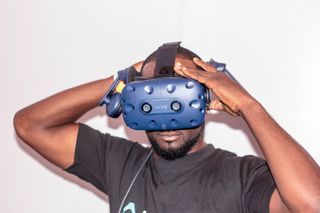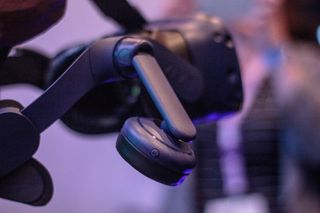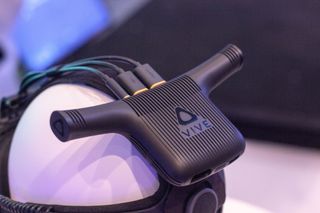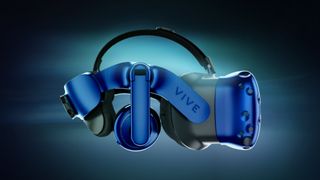
Announced at CES 2018, the HTC Vive Pro is set to bring a few key upgrades to the VR headset that many have been asking for. If you happen to already have the original Vive setup, you might be wondering whether or not it's worth upgrading to the newer headset, which will cost about $800 and is expected to be released April 5, 2018. Let's have a look at exactly what's new and what those changes mean, both for current owners and anyone who's interested in getting involved in the future.
HTC Vive vs. HTC Vive Pro: Tech specs

| Category | HTC Vive | HTC Vive Pro |
|---|---|---|
| Display | Dual AMOLED 3.6 inches | Dual AMOLED 3.5 inches |
| Resolution | 1,080 x 1,200 (2,160 x 1,200) | 1,440 x 1,600 (2,880 x 1,600) |
| FOV | 110 degrees | 110 degrees |
| Refresh rate | 90Hz | 90Hz |
| Connection | USB-A 2.0 HDMI 3.5mm audio | USB-C 3.0 DisplayPort 1.2 |
HTC Vive vs. HTC Vive Pro: Display

The biggest change when it comes to hardware specs is the display. The Vive Pro is now sporting higher-resolution screens, offering up 615 pixels per inch (PPI). This is a 37 percent increase over the original Vive, and it also means about a 78 percent increase in overall pixels.
If you find that the original Vive's picture is a bit blurry, especially when trying to read text, The Vive Pro is no doubt going to be a big improvement. The dreaded screen-door effect, a grid of thin lines that seems to jump out at you from the display when you focus on it, has also seemingly been alleviated.
Anyone in search of the best picture in a VR headset will definitely want to check out the new Vive Pro.
HTC Vive vs. HTC Vive Pro: Design

To complement the new display inside the Vive Pro, HTC created a new face cushion — the part that seals the headset to your face — to be more comfortable and block out more light. HTC says the surface area of the face gasket, including face pad and nose pad, has been increased by 24 percent to help spread the weight more evenly. Whereas the original Vive's foam padding was just foam, the Vive Pro is lined with cloth for a softer experience.
To help differentiate the two headsets, the Vive Pro is made of a mix of blue and black plastics, whereas the original Vive is solid black. On the front of the Vive Pro's display housing are now two cameras that contribute to an improved Chaperone system that keeps you from bumping into walls and furniture.
The other major redesign has to do with the headstrap. The original Vive's elastic and Velcro hair-catcher seemed like a decent solution when we first saw it, but the Vive Pro's new padded plastic headmount — resembling the original Vive's deluxe audio strap — is a step in the right direction. You push the display up against your face, slide the strap over your head, and you're pretty much ready to go. It's comfortable, it's secure, and it also holds the new built-in headphones.
Get the Windows Central Newsletter
All the latest news, reviews, and guides for Windows and Xbox diehards.
The design section boils down to this question: Does the original Vive seem uncomfortable? The Vive Pro can likely alleviate some of the problems associated with wearing a box on your face for lengthy periods of time.
HTC Vive vs. HTC Vive Pro: Audio

The original Vive's solution for audio is a 3.5mm jack that you can plug a set of headphones into. While it works as intended, you're dealing with another cable that occasionally gets tangled with whatever else you have going on up top.
Following in the footsteps of Oculus, the Vive Pro now has built-in headphones (that are removable) attached securely to the redesigned strap. The headset and headphones are Hi-Res Audio certified, so you're getting some of the highest quality digital sound without the bulky hardware.
The Vive Pro also takes advantage of 3D spatial sound to improve immersiveness, and new dual microphones come with some neat additions. Noise cancellation keeps out ambient noise while you're in-game, but Alert Mode and Conversation Mode allow you to hear if someone is speaking to you in real life. It's an elegant solution to the dangers of being completely cut off from the physical world while wearing the headset.
HTC Vive vs. HTC Vive Pro: Tracking

HTC has announced that during the first quarter of 2018, there will be an upgrade program where current Vive owners can get in on the new headset. For the time being, the Vive Pro will work with the older motion controllers (wands) and lighthouse sensors.
Later this year, it's expected that complete kits will be made available containing the Vive Pro, updated lighthouse sensors, and updated wands. The new sensors are expected to increase the play area to about 10 meters by 10 meters (32 feet by 32 feet). That's significantly more space than the original Vive was capable of tracking, making for a more immersive play-style as long as space allows.
Also expected to be coming later this year is the Vive wireless adapter, which uses WiGig technology to remove the physical PC tether. This is a huge step for the Vive, and VR as a whole, especially because you're getting a 60GHz transfer rate for audio and video data. The best part? The wireless adapter will work with the original Vive and the Vive Pro, though it will be sold separately.
HTC Vive vs. HTC Vive Pro: Should you upgrade?

Diehard HTC Vive fans are no doubt already looking at the Vive Pro and reordering their budgets in time for the April 5 release date (you can pre-order now in anticipation). The increased display resolution and new, comfortable design — including the strap with built-in headphones — will only cater to anyone who spends hours at a time in VR.
If you're a casual user but are most excited about the wireless adapter, you can always buy it first and try it out on your original Vive before deciding whether or not you want the full package. Oh, and for you business owners with a VR amusement park in the works, the increased range coming with the new sensors will no doubt be an interesting perk to consider.
Updated March 19, 2018: We've refreshed this article to include pricing and release information for the Vive Pro.

Cale Hunt brings to Windows Central more than eight years of experience writing about laptops, PCs, accessories, games, and beyond. If it runs Windows or in some way complements the hardware, there’s a good chance he knows about it, has written about it, or is already busy testing it.
